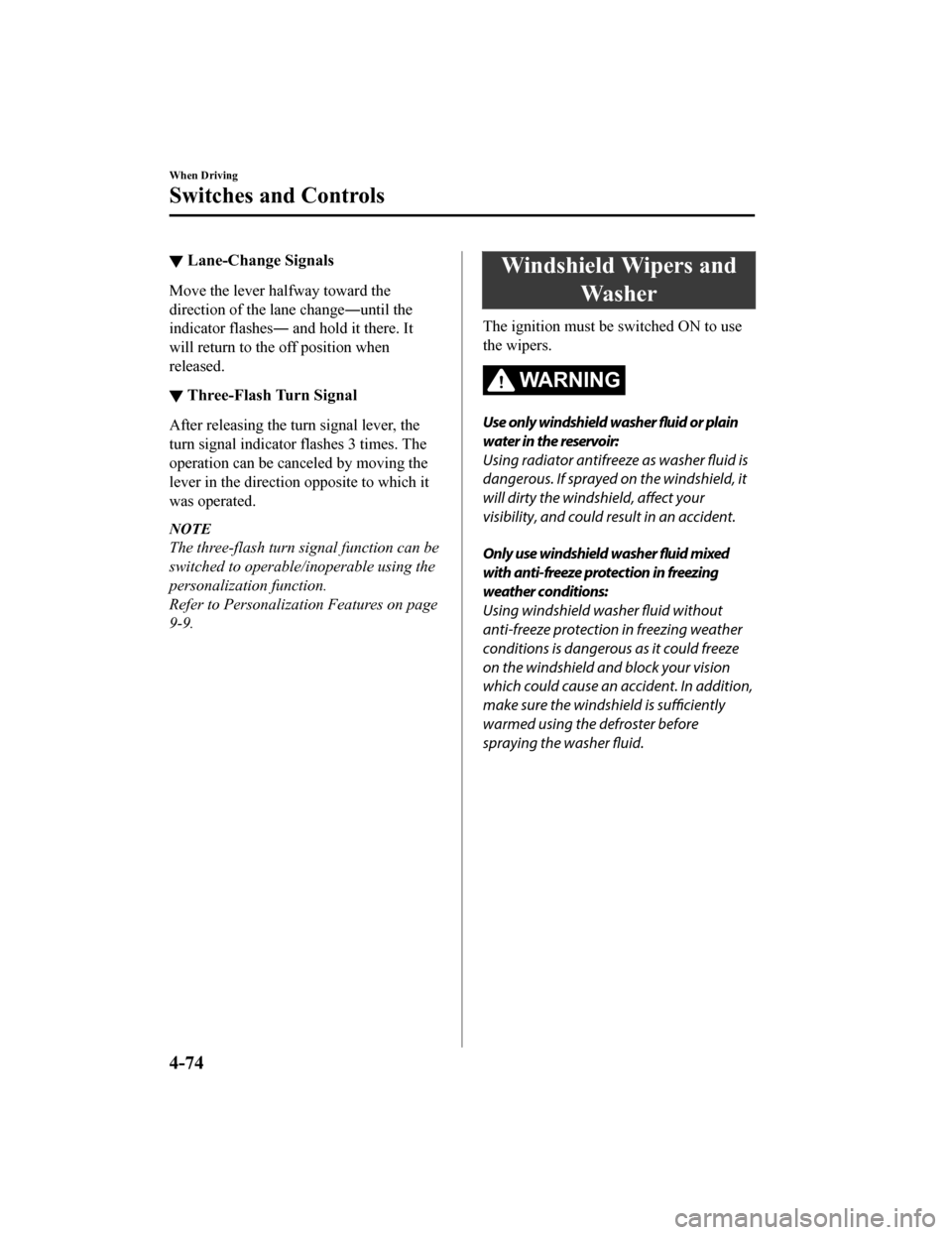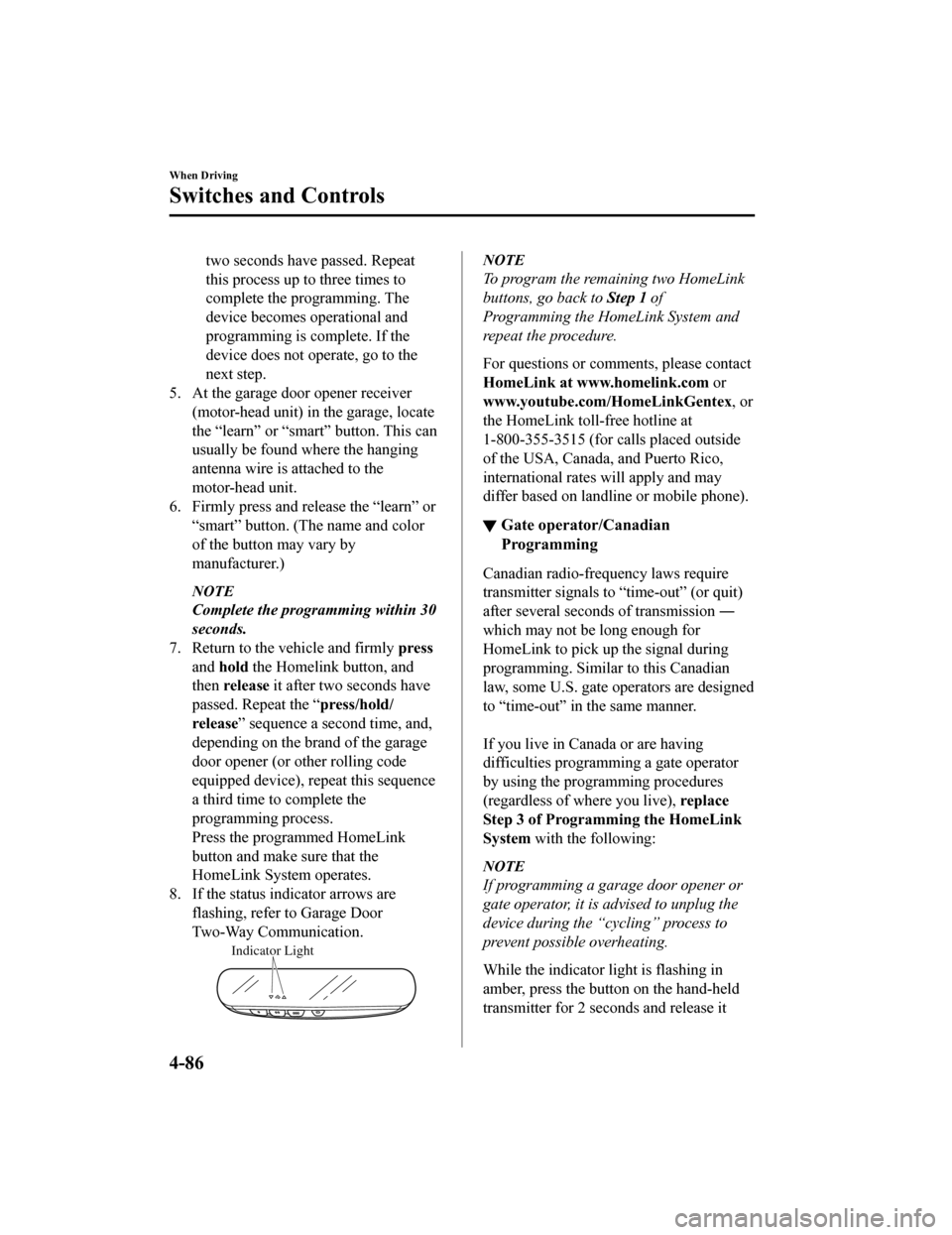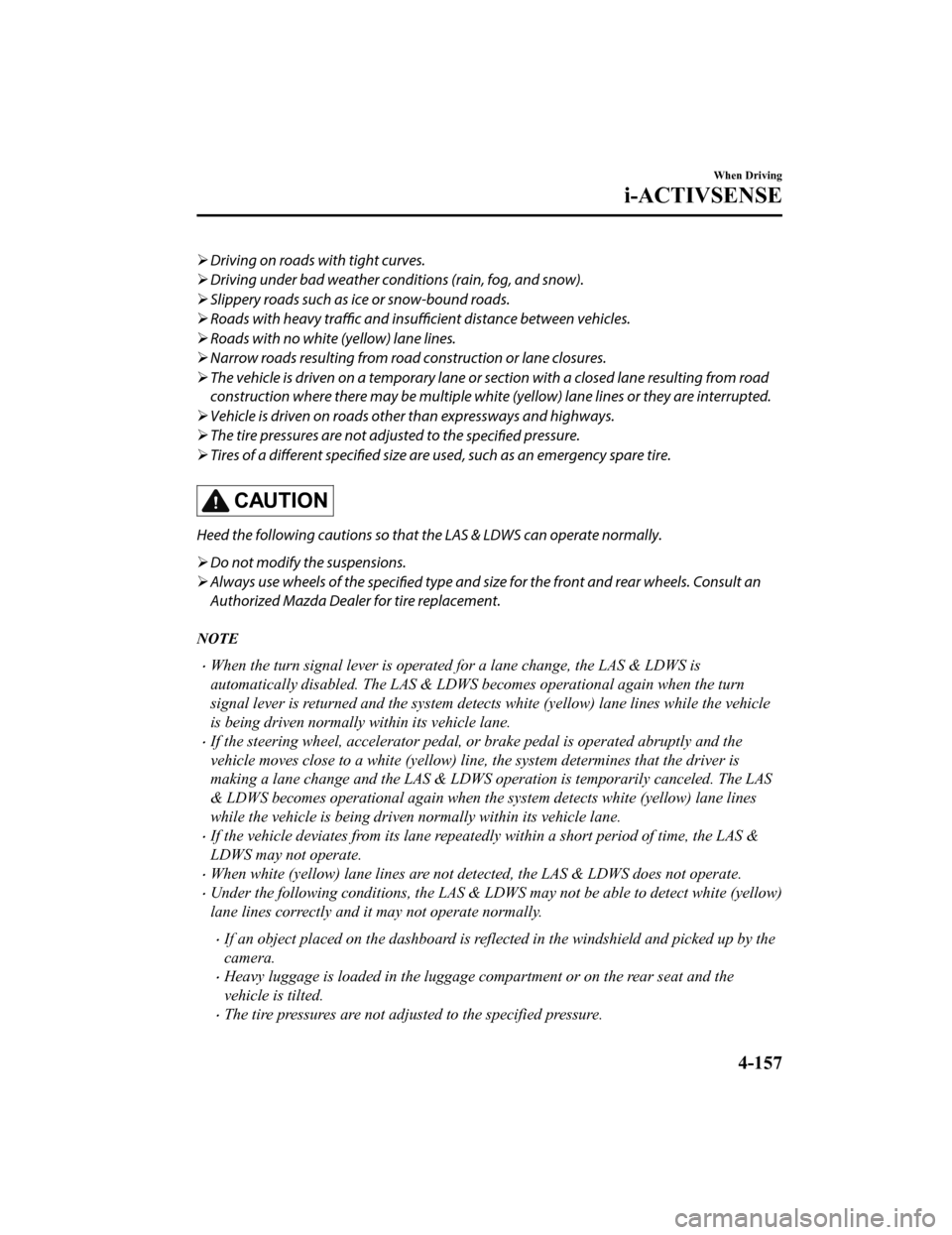turn signal MAZDA MODEL CX-9 2020 (in English) Owner's Manual
[x] Cancel search | Manufacturer: MAZDA, Model Year: 2020, Model line: MODEL CX-9, Model: MAZDA MODEL CX-9 2020Pages: 706
Page 240 of 706

Ō¢╝Lane-Change Signals
Move the lever halfway toward the
direction of the lane change
ŌĆĢuntil the
indicator flashes ŌĆĢ and hold it there. It
will return to the off position when
released.
Ō¢╝ Three-Flash Turn Signal
After releasing the turn
signal lever, the
turn signal indicator flashes 3 times. The
operation can be canceled by moving the
lever in the direction opposite to which it
was operated.
NOTE
The three-flash turn signal function can be
switched to operable/inoperable using the
personalization function.
Refer to Personalization Features on page
9-9.
Windshield Wipers and Wa s h e r
The ignition must be switched ON to use
the wipers.
WA R N I N G
Use only windshield washer fluid or plain
water in the reservoir:
Using radiator antifreeze as washer fluid is
dangerous. If sprayed on the windshield, it
will dirty the windshield, affect your
visibility, and could result in an accident.
Only use windshield washer fluid mixed
with anti-freeze protection in freezing
weather conditions:
Using windshield washer fluid without
anti-freeze protection in freezing weather
conditions is dangerous as it could freeze
on the windshield and block your vision
which could cause an accident. In addition,
make sure the windshield is sufficiently
warmed using the defroster before
spraying the washer fluid.
When Driving
Switches and Controls
4-74
CX-9_8HT8-EA-19I_Edition2_old 2019-9-24 13:14:55
Page 246 of 706

Horn
To sound the horn, press the mark on
the steering wheel.
Hazard Warning Flasher
The hazard warning lights should always
be used when you stop on or near a
roadway in an emergency.
The hazard warning lights warn other
drivers that your vehicle is a traffic hazard
and that they must take extreme caution
when near it.
Depress the hazard warning flasher and all
the turn signals will flash. The hazard
warning indicator lights in the instrument
cluster flash simultaneously.
NOTE
’éĘThe turn signals do not work when the
hazard warning lights are on.
’éĘCheck local regulations about the use of
hazard warning lights while the vehicle
is being towed to verify that it is not in
violation of the law.
When Driving
Switches and Controls
4-80
CX-9_8HT8-EA-19I_Edition2_old 2019-9-24 13:14:55
Page 249 of 706

of the button may vary by
manufacturer.)
NOTE
Complete the programming within 30
seconds.
9. Return to the vehicle and firmly press,
hold for two seconds and release the
programmed HomeLink button. Repeat
the ŌĆ£ press/hold/release ŌĆØ sequence a
second time, and, depending on the
brand of the garage door opener (or
other rolling code equipped device),
repeat this sequence a third time to
complete the programming process.
HomeLink should now activate your
rolling code equipped device.
NOTE
To program the remaining two HomeLink
buttons, begin with ŌĆ£ProgrammingŌĆØ ŌĆĢ
step 1
For questions or comments, please contact
HomeLink at www.homelink.com or
1-800-355-3515 .
Ō¢╝Gate operator/Canadian
Programming
Canadian radio-frequency laws require
transmitter signals to ŌĆ£time-outŌĆØ (or quit)
after several seconds of transmission
ŌĆĢ
which may not be long enough for
HomeLink to pick up the signal during
programming. Similar to this Canadian
law, some U.S. gate operators are designed
to ŌĆ£time-outŌĆØ in the same manner.
If you live in Canada or you are having
difficulties programming a gate operator
by using the ŌĆ£ProgrammingŌĆØ procedures
(regardless of where you live), replace
ŌĆ£Programming HomeLinkŌĆØ step 3 with
the following:
NOTE
If programming a garage door opener or
gate operator, it is advised to unplug the
device during the ŌĆ£cyclingŌĆØ process to
prevent possible overheating.
Continue to press and hold the HomeLink
button while you press and release ŌĆĢ
every two seconds (ŌĆ£cycleŌĆØ) your
hand-held transmitter until the frequency
signal has successfully been accepted by
HomeLink. (The indicator light will flash
slowly and then rapidly.)
Proceed with ŌĆ£ProgrammingŌĆØ step 4 to
complete.
Ō¢╝ Operating the HomeLink System
Press the programmed HomeLink button
to operate a programmed device. The code
will continue being transmitted for a
maximum of 20 seconds.
Ō¢╝Reprogramming the HomeLink
system
To program a device to HomeLink using a
HomeLink button previously trained,
follow these steps:
1. Press and hold the desired HomeLink
button. DO NOT release the button.
2. The indicator light will begin to flash
after 20 seconds. Without releasing the
HomeLink button, proceed with
ŌĆ£ProgrammingŌĆØ - step 1.
Ō¢╝ Erasing Programmed HomeLink
Buttons
To erase the existing programming from
all three operating channels, press and
hold the two outside buttons (
, ) on
When Driving
Switches and Controls
4-83
CX-9_8HT8-EA-19I_Edition2_old
2019-9-24 13:14:55
Page 252 of 706

two seconds have passed. Repeat
this process up to three times to
complete the programming. The
device becomes operational and
programming is complete. If the
device does not operate, go to the
next step.
5. At the garage door opener receiver (motor-head unit) in the garage, locate
the ŌĆ£learnŌĆØ or ŌĆ£smartŌĆØ button. This can
usually be found where the hanging
antenna wire is attached to the
motor-head unit.
6. Firmly press and release the ŌĆ£learnŌĆØ or
ŌĆ£smartŌĆØ button. (The name and color
of the button may vary by
manufacturer.)
NOTE
Complete the programming within 30
seconds.
7. Return to the vehicle and firmly press
and hold the Homelink button, and
then release it after two seconds have
passed. Repeat the ŌĆ£ press/hold/
release ŌĆØ sequence a second time, and,
depending on the brand of the garage
door opener (or other rolling code
equipped device), repeat this sequence
a third time to complete the
programming process.
Press the programmed HomeLink
button and make sure that the
HomeLink System operates.
8. If the status indicator arrows are flashing, refer to Garage Door
Two-Way Communication.
Indicator Light
NOTE
To program the remaining two HomeLink
buttons, go back to Step 1 of
Programming the HomeLink System and
repeat the procedure.
For questions or comments, please contact
HomeLink at www.homelink.com or
www.youtube.com/HomeLinkGentex , or
the HomeLink toll-free hotline at
1-800-355-3515 (for calls placed outside
of the USA, Canada, and Puerto Rico,
international rates will apply and may
differ based on landline or mobile phone).
Ō¢╝ Gate operator/Canadian
Programming
Canadian radio-frequency laws require
transmitter signals to ŌĆ£time-outŌĆØ (or quit)
after several seconds of transmission
ŌĆĢ
which may not be long enough for
HomeLink to pick up the signal during
programming. Similar to this Canadian
law, some U.S. gate operators are designed
to ŌĆ£time-outŌĆØ in the same manner.
If you live in Canada or are having
difficulties program ming a gate operator
by using the programming procedures
(regardless of where you live), replace
Step 3 of Programming the HomeLink
System with the following:
NOTE
If programming a garage door opener or
gate operator, it is advised to unplug the
device during the ŌĆ£cyclingŌĆØ process to
prevent possible overheating.
While the indicator light is flashing in
amber, press the button on the hand-held
transmitter for 2 seconds and release it
When Driving
Switches and Controls
4-86
CX-9_8HT8-EA-19I_Edition2_old 2019-9-24 13:14:55
Page 285 of 706

NOTE
The timing in which the system switches the headlights changes under the following
conditions. If the system does not switch the headlights appropriately, manually switch
between high and low beams according to the visibility as well as road and traffic
conditions.
’éĘWhen there are sources of light in the area such as street lamps, illuminated signboards,
and traffic signals.
’éĘWhen there are reflective objects in the surrounding area such as reflective plates and
signs.
’éĘWhen visibility is reduced under rain, snow and foggy conditions.
’éĘWhen driving on roads with sharp turn or hilly terrain.
’éĘWhen the headlights/rear lamps of vehicles in front of you or in the opposite lane are dim
or not illuminated.
’éĘWhen there is sufficient darkness such as at dawn or dusk.
’éĘWhen the luggage compartment is loaded with heavy objects or the rear passenger seats
are occupied.
’éĘWhen visibility is reduced due to a vehicle in front of you spraying water from its tires
onto your windshield.
Ō¢╝ To Operate the System
The HBC operates to switch the headlights
automatically between high and low
beams after the igniti
on is switched ON
and the headlight switch is in the AUTO
and high beam position.
The HBC determines that it is dark based
on the brightness of the surrounding area.
At the same time, the HBC indicator light
(green) in the in strument cluster
illuminates.
NOTE
’éĘWhen the vehicle speed is about 30 km/h
(19 mph) or more, the headlights
automatically switch to high beams
when there are no vehicles ahead or
approaching in the opposite direction.
When the vehicle speed is less than
about 20 km/h (12 mph), the HBC
switches the headlights to low beams.
’éĘThe low beams may not switch to high
beams when cornering.
’éĘOperation of the HBC function can be
disabled. Refer to Personalization
Features on page 9-9.
Ō¢╝ Manual Switching
Switching to low beams
Shift the lever to th
e low beam position.
The HBC indicator light (green) turns off.
When Driving
i-ACTIVSENSE
4-119
CX-9_8HT8-EA-19I_Edition2_old 2019-9-24 13:14:55
Page 287 of 706

Blind Spot Monitoring (BSM)*
The BSM is designed to assist the driver in checking the area to the rear of the vehicle on
both sides during lane changes by notifying the driver of the presence of vehicles
approaching from the rear in an adjacent lane.
The BSM detects vehicles approaching from the rear while traveling in the forward
direction at a speed of 10 km/h (6.3 mph) or faster and notifies the driver by turning on the
BSM warning indicator light and displaying the vehicle detection screen.
If the turn signal lever is operated to signal a turn in the direction in which the BSM
warning indicator light is illuminated while the approaching vehicle is detected, the BSM
notifies the driver of possible danger by turnin g on the BSM warning indicator light, and by
activating the warning sound and the warning screen indicator display.
The detection area on this system covers the driving lanes on both sides of the vehicle and
from the rear part of the front doors to about 50 m (164 ft) behind the vehicle.
Detection areas
Your vehicle
WA R N I N G
Always check the surrounding area visually before making an actual lane change:
The system is only designed to assist you in checking for vehicles at your rear when making a
lane change. Due to certain limitations with
the operation of this system, the BSM warning
indicator light, the warning sound and the warning screen indicator display may not activate
or they might be delayed even though a vehicle is in an adjacent driving lane. Always make it
your responsibility as a driver to check the rear.
When Driving
i-ACTIVSENSE
*Some models.4-121
CX-9_8HT8-EA-19I_Edition2_old 2019-9-24 13:14:55
Page 290 of 706

Ō¢╝Blind Spot Monitoring (BSM) Warning I
ndicator Light/Display Indicator/Blind
Spot Monitoring (BSM) Warning Beep
The BSM or Rear Cross Traffic Alert (RCTA) system notifies the driver of the presence of
vehicles in adjacent lanes or at the rear of the vehicle using the BSM warning indicator
light, the warning sound and the display indi cator (BSM) while the systems are operational.
BSM warning indicator lights
The BSM warning indicator lights are equipp ed on the left and right door mirrors. The
warning indicator lights turn on when a vehicle approaching from the rear in an adjacent
lane is detected.
When the ignition is switched ON, the warning indicator light turns on momentarily and
then turns off after a few seconds.
Forward driving (BSM operation)
The BSM detects vehicles approaching from the rear and turns on the BSM warning
indicator lights equipped on the door mirrors according to the conditions. Additionally,
while a BSM warning indicator light is illumina ted, if the turn signal lever is operated to
signal a turn in the direction in which the BSM warning indicator light is illuminated, the
BSM warning indicator light flashes.
Reverse driving (Rear Cross Traffic Alert (RCTA) system operation)
The Rear Cross Traffic Alert (RCTA) system detects vehicles approaching from the left and
right of your vehicle and flashe s the BSM warning indicator lights.
When Driving
i-ACTIVSENSE
4-124
CX-9_8HT8-EA-19I_Edition2_old 2019-9-24 13:14:55
Page 291 of 706

Function for cancelling illumination dimmer
If the BSM warning indicator lights turn on when the parking lights are turned on, the
brightness of the BSM warning indicator lights is dimmed.
If the BSM warning indicator lights are diffic ult to see due to glare from surrounding
brightness when traveling on snow-covered roads or under foggy conditions, press the
dimmer cancellation button to cancel the dimmer and increase the brightness of BSM
warning indicator lights when they turn on.
Refer to Dashboard Illumination on page 4-19, 4-35.
Display indicator
The detected approaching vehicle and warning are displayed in the multi-information
display and active driving display when the vehicle is moving forward (BSM operational).
Multi-information Display Active Driving Display
Detection and warning indicator Detection and warning indicator
The detected direction is displayed with a detection indicator (white) when an approaching
vehicle is detected. In addition, if the turn signal lever is operated to signal a lane change
while the vehicle is detected, the display changes the color (amber) of the warning indicator.
BSM warning beep
The BSM warning beep is activated simultan eously with the flashing of a BSM warning
indicator light.
Ō¢╝ Canceling Operation of Blind Spot
Monitoring (BSM)
The BSM system can be set to inoperable.
Refer to Personalization Features on page
9-9.
When the BSM is set to inoperable, the
BSM and Rear Cross Traffic Alert
(RCTA) systems are turned off and the
BSM OFF indicator ligh
t in the instrument
cluster turns on.
When Driving
i-ACTIVSENSE
4-125
CX-9_8HT8-EA-19I_Edition2_old 2019-9-24 13:14:55
Page 323 of 706

’āśDriving on roads with tight curves.
’āś Driving under bad weather conditions (rain, fog, and snow).
’āś Slippery roads such as ice or snow-bound roads.
’āś Roads with heavy traffic and insufficient distance between vehicles.
’āś Roads with no white (yellow) lane lines.
’āś Narrow roads resulting from road construction or lane closures.
’āś The vehicle is driven on a temporary lane or section with a closed lane resulting from road
construction where there may be multiple white (yellow) lane lines or they are interrupted.
’āś Vehicle is driven on roads oth er than expressways and highways.
’āś The tire pressures are not adjusted to the
specified pressure.
’āś Tires of a different specified size are used, such as an emergency spare tire.
CAUTION
Heed the following cautions so that the LAS & LDWS can operate normally.
’āśDo not modify the suspensions.
’āś Always use wheels of the
specified type and size for the front and rear wheels. Consult an
Authorized Mazda Dealer for tire replacement.
NOTE
’éĘWhen the turn signal lever is operated for a lane change, the LAS & LDWS is
automatically disabled. The LAS & LDWS becomes operational again when the turn
signal lever is returned and the system detects white (yellow) lane lines while the vehicle
is being driven normally within its vehicle lane.
’éĘIf the steering wheel, accelerator pedal, or brake pedal is operated abruptly and the
vehicle moves close to a white (yellow) line, the system determines that the driver is
making a lane change and the LAS & LDWS operation is temporarily canceled. The LAS
& LDWS becomes operational again when the system detects white (yellow) lane lines
while the vehicle is being driven normally within its vehicle lane.
’éĘIf the vehicle deviates from its lane repeatedly within a short period of time, the LAS &
LDWS may not operate.
’éĘWhen white (yellow) lane lines are not detected, the LAS & LDWS does not operate.
’éĘUnder the following conditions, the LAS & LDWS may not be able to detect white (yellow)
lane lines correctly and it may not operate normally.
’éĘIf an object placed on the dashboard is reflected in the windshield and picked up by the
camera.
’éĘHeavy luggage is loaded in the luggage compartment or on the rear seat and the
vehicle is tilted.
’éĘThe tire pressures are not adjusted to the specified pressure.
When Driving
i-ACTIVSENSE
4-157
CX-9_8HT8-EA-19I_Edition2_old 2019-9-24 13:14:55
Page 327 of 706

’éĘThe timing at which the lane departure
warning is activated and the steering
wheel operation assist is performed
varies.
’éĘThe following settings for the LAS &
LDWS can be changed. Refer to
Personalization Features on page
9-9.
’éĘSteering operation assist operational/
non-operational
’éĘCancel sensitivity (likelihood of
steering assist)
Vehicle lane line display
When the LAS & LDWS becomes
operational while on standby, the vehicle
lane lines are displayed in the
multi-information display and the active
driving display. In the vehicle lane lines
display indicating the operation status, the
color of the vehicle lane lines being
detected changes to white.
(Stand-by status)
Multi-information Display
Active Driving Display
(Operational status)
Multi-information Display
Active Driving Display
Auto cancel
In the following cases, the LAS & LDWS
is automatically canceled, the LAS &
LDWS warning indication (amber) turns
on, and an alert is displayed. When the
LAS & LDWS become operational, the
system turns back on automatically.
’éĘThe temperature inside the camera is
high or low.
’éĘThe windshield around the camera is
foggy.
’éĘThe windshield around the camera is
blocked by an obstruction, causing poor
forward visibility.
Auto cancel of warning/steering assist
When the following operations are
performed, the LAS & LDWS operation is
canceled automatically. The LAS &
LDWS resumes automatically after the
operation.
’éĘThe steering wheel is operated abruptly.
’éĘThe brake pedal is operated.
’éĘThe accelerator pedal is operated.
(To cancel the automatic sensitivity
cancel function, deselect ŌĆ£Cancel
sensitivityŌĆØ in the personalization
features setting.)
’éĘThe turn signal lever is operated.
When Driving
i-ACTIVSENSE
4-161
CX-9_8HT8-EA-19I_Edition2_old 2019-9-24 13:14:55